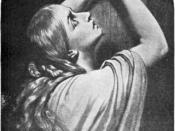Therapy, Counseling & Protection Program for former Women Sex SlavesThe Magdalene ProgramThis particular program is unique because its focus is on an extreme subject of former sex workers- women who have been pimped under the heading of 'sex slaves'. They usually start young and are in the position they were in because they trusted a boyfriend, a friend and a husband due to their lot n life ÃÂ poverty, runaways compounded by low self-esteem that allows for easy control of their persons; their vulnerability were exploited. Women who were smuggled into the country promised with a better life ending up in the sex trade, teenagers tricked into prostitution and drug dependencies, wives traded by their husbandÃÂs monetary gain. The connotation of slaves explains the nature of their position. At the time when they were active in the sex trade, they were powerless to do anything about it. Whatever their restraints, physical, emotional, chemical, social ÃÂ they had no choice other than uncertainty, fear or to look the other way and take all the abuse that comes with being a slave worker comes with the faintest hope of survival/rescue, a lot like the infamous 'comfort women' the Japanese took for the purposes of sex when they invaded and captured much of Asia during WW2.
They picked the most attractive local women from the captured populace and kept them in a sort of common 'harem' for their soldiers. Up till now, the scars of many of said comfort women haven't healed and it has taken a while for the Japanese government to recognize said abuses.
This program is run not by a halfway home but by a Christian Charity. Spiritual healing contributes much to overall therapy and influences much of the emotional, physical and mental aspect. The charity believes that the tenets of faith will enable these women to fight their demons and rebuild themselves. Just to make sure however they also employ licensed clinicians and therapists to oversee the more 'expert' and clinical aspects of it. All expenses are paid for by the charity and they are supported by varied donors ÃÂ personal and corporate. The program is located in Santa Barbara, California although the women are from all over the United States. They came from similar social welfare programs ran by Christian churches all over the country and usually, their cases displayed extensive experience of violence, abuse and trauma ÃÂ qualifying them to be sent to this special center whose exact name and location are classified to protect the women. The data though as well as results are distributed throughout the participating charities, corporate and personal donors as well as concerned state and federal agencies. Some of the women are under police protection due to the fact that they've pledged to turn state witness against their 'captors', big business prostitution gangs and cabals who find it, pursuant to their interest, to have said women disposed of.
The Therapy ProgramThere are 3 components to the therapy program spiritual, cynical/psychological and then the education-rehabilitation-physical stage which is considered a necessary and combined aspect to ready the subjects for successful reintegration to society. The program starts out with a spiritual approach prior to the introduction of the clinical aspects which is then integrated with the spiritual program. As I mentioned earlier this is a Christian Charity program and the aim is to 'strengthen' the spiritual healing via the Christian way. Faith plays a major role here. The women are seen to be akin to the situation of Mary Magdalene who was 'saved' by Jesus from stoning by a mob and, instead of judging here, gave her what is described by Christians as 'Salvation'. The story of Mary Magdalene and her relevance to the Christian faith is of utmost importance to the 'spiritual' healing of these women. The therapy includes talks, discussions, prayer sessions, bible studies and meditation within the peaceful confines of the center near a convent. This program is overseen by nuns and priests of varied orders as well as Pastors and Men & Women of faith from varied other Christian denominations ÃÂ Anglican, Protestant, 7th-day Adventists, etc. The image of Mary Magdalene to many of this women seem like mirror images of their own experiences and it gives them hope as well as purpose to make things better, to change. The spiritual component also motivates and gives courage.
The clinical component is an application of cognitive behavior therapy programs. Depressions, anger, fears manifested in other physiological disorders are among the many encountered in most of these cases. Using both top-down and then bottom-up approaches, the program applied is cognitive in nature since since the emphasis in therapy is upon assisting the victims (the former sex-slaves) to develop and utilize cognitive strategies to manage the effects of their trauma, and eventually in doing so work around, if not confront the source of their trauma at a personal level to function as close as possible to what is considered acceptably ÃÂnormalÃÂ despite the challenges of their trauma. In this instance, the cognitive approach is meant to change faulty or distorted cognitive processes, that which had been damaged by the trauma of having been subjected to sexual slavery. The realities of that condition at the time of enslavement had distorted the victimÃÂs views of the world and for many trust and security are major issues. The cognitive approach helps them to deal with these at a clinician-patient situation with sessions that facilitate dialogue, communication and other series activities that include ÃÂreal worldÃÂ situations meant to curb a fear, strike a realization and teach confidence as well as self-reliance & security. At times this also includes psychiatric programs meant to intervene the most severe cases where hospitalization is an option, that and chemical correction by way of medication and regulated intake of prescribed drugs. It is important to note that while the Clinical-program is implemented, it is made to coincide hand in hand with the spiritual program.
Education-Physical-Rehabilitation programOnce the victims have made considerable improvements, they are enrolled in a skills and education program made to endow them with confidence & skills to reintegrate and find their own means of positive employment when the time comes that they can be apart of society once again. The physical component is also essential as physical activity endorses the production of positive chemicals in the body, like endorphins. Exercise, running, gym activities, outdoor, activities are made available for them. They can also, at this stage volunteer to work with new ÃÂpatientsÃÂ to encourage positive social support among their own fellow former ÃÂMagdalenesÃÂ. Combined, this becomes a rehabilitation program that reinforces newfound identities.
Effectivity & Measuring ToolsThe measuring tools of the program are indicated in the positive results they have so far released. In 2008, of the 115 patients enrolled in the program, 50% were deemed ready for positive reentry into society. The turnaround time is usually 2 years and many, despite their success in the real world find their way back to the program to become mentors of new patients/enrollees. The program is so successful that it has become a model for similar Christian-based programs in other Christian countries like the Philippines, Germany, Italy and France.
ConclusionCognitive Approaches are effective due to the fact that while the principles are universal, they can be individualized to suit the needs of subjects undergoing said treatment. It also has general social applications like in management, politics and business. Taken from this way though, where it is used to help victims of horrendous crimes, women who were one sex-slaves, the positive contribution of said approach can only promise so much more. It is only the beginning though as proven with this program, it requires a few other components aside from that of which are purely clinical in nature to ensure success.
References:Feuerstein, R., Rand, Y., Hoffman, M., & Miller, R. (1980), Instrumental enrichment: An intervention program for cognitive modifiability, Baltimore, MD: University Park Press.
Missiuna, C., & Malloy-Miller, T. (1996), The cognitive revolution: Making top-down a reality, Ontario Association of Children's Rehabilitation Services Conference, Burlington, Ontario.
Parrott III, L. (2003), Counseling and psychotherapy (2nd ed.), Belmont, CA: Brooks/Cole/Thomson Learning.




